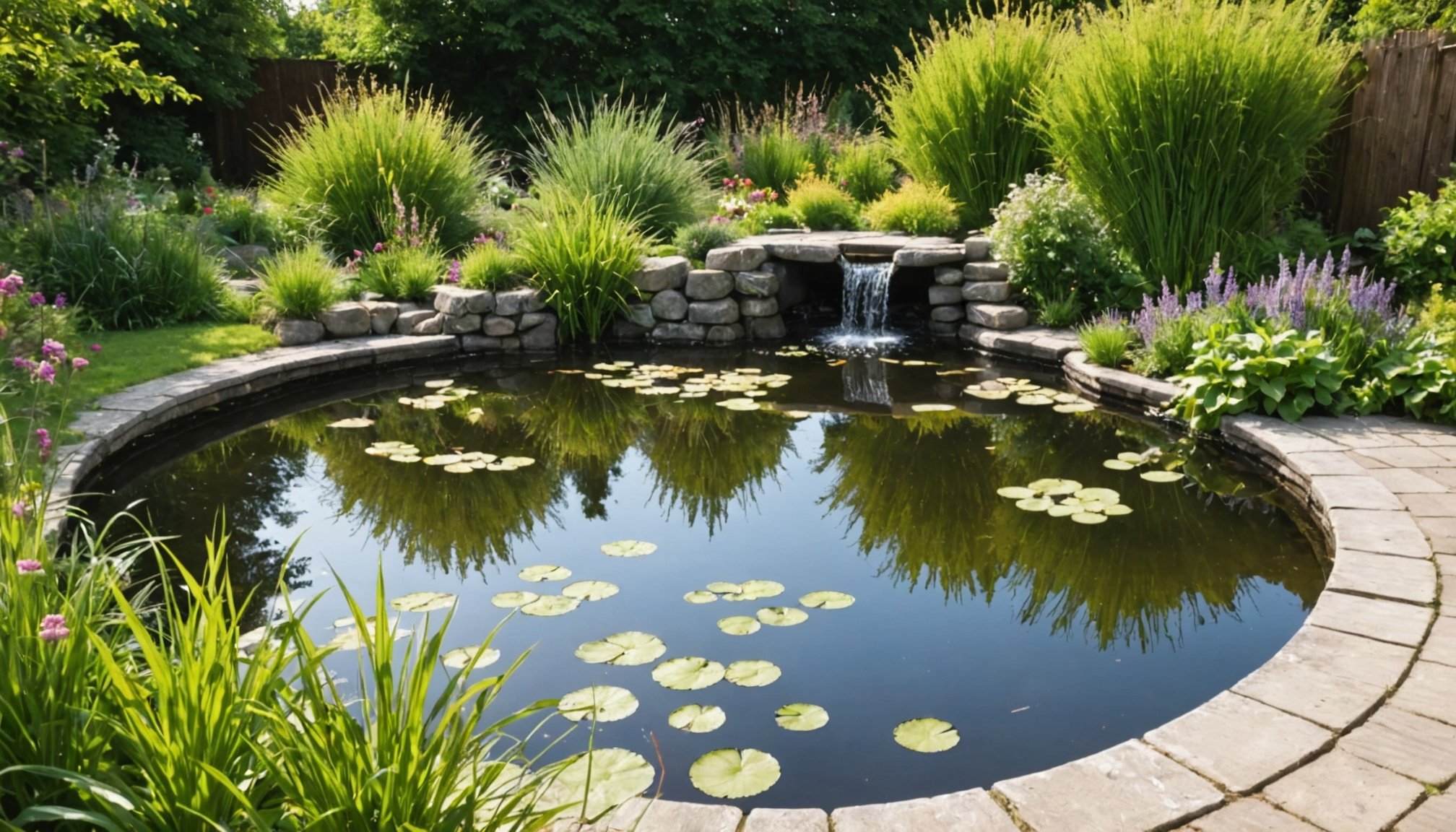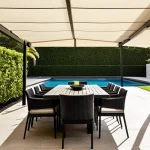A wildlife pond can transform your small UK garden into a vibrant ecosystem. This guide offers clear, step-by-step instructions to create a serene space that attracts diverse wildlife. From choosing the right location to selecting aquatic plants and creating habitats, you'll find everything you need to know. Embrace this rewarding project and witness the joy of nature right at your doorstep. Whether you’re a seasoned gardener or a beginner, crafting your own wildlife pond can be a fulfilling experience.
Understanding the Importance of Wildlife Ponds
Wildlife ponds are invaluable assets to ecosystems, offering a myriad of benefits for wildlife. These ponds serve as crucial habitats, supporting a diverse range of species. By providing a reliable water source, they attract amphibians, insects, birds, and mammals, each contributing to the local biodiversity. This diversity is essential for maintaining ecological balance and resilience.
A voir aussi : Transform Your Compact UK Flat: The Ultimate Guide to Vertical Gardening for Space Optimization
In urban garden ecosystems, wildlife ponds play a pivotal role. They transform gardens into vibrant, thriving environments, creating a mini-ecosystem that supports both flora and fauna. Urban areas often lack natural water sources, making these ponds vital for sustaining local wildlife populations. They offer a sanctuary amidst concrete landscapes, allowing species to flourish.
Moreover, wildlife ponds contribute to the overall health of ecosystems by promoting pollination and pest control. The presence of diverse species encourages natural processes that benefit plant growth and sustainability. As such, they are not only beneficial for wildlife but also enhance the aesthetic and ecological value of gardens.
Avez-vous vu cela : How to Integrate Solar Lighting into Your UK Garden for Sustainability?
By understanding the importance of wildlife ponds, gardeners and urban planners can foster environments that support biodiversity and ecological health. Embracing these natural habitats ensures a harmonious coexistence between urban development and wildlife conservation.
Planning Your Wildlife Pond
When planning a wildlife pond, site selection is critical. The right location can significantly impact the pond's success in attracting and sustaining wildlife. Consider areas with adequate sunlight, as this encourages plant growth, which in turn supports a diverse range of species. Avoid placing the pond under trees to minimize leaf litter, which can affect water quality.
Assessing your garden layout is essential for optimal pond placement. Observe the natural flow of water in your garden to identify low-lying areas where water naturally collects. These spots are ideal for pond installation, as they require minimal alteration to the landscape. Consider how the pond will integrate with existing garden features, ensuring it complements the overall aesthetic.
Identifying potential obstacles is also crucial. Structures like fences or walls may cast shadows, affecting the pond's microclimate. Additionally, ensure the site is accessible for maintenance and observation. Opportunities for enhancing biodiversity should not be overlooked. Incorporate native plants around the pond to create habitats for various species, and design features like shallow edges to accommodate different wildlife needs. Proper planning ensures your pond becomes a thriving ecosystem, enriching your garden's biodiversity.
Designing Your Pond Size and Shape
When it comes to creating a wildlife pond, pond size and pond shape are crucial design considerations that can determine the diversity and abundance of wildlife it attracts. For small UK gardens, a pond size of at least 2 square meters is recommended to support a healthy ecosystem. Larger ponds can accommodate more species, but even modestly sized ponds can significantly enhance biodiversity.
The shape of your pond is equally important. Irregular shapes with varied depths are advantageous as they mimic natural water bodies, providing diverse habitats for different species. Shallow edges are particularly beneficial, offering safe access for amphibians and birds. Circular or oval ponds are popular for their simplicity and ease of integration into garden landscapes, while kidney-shaped ponds add a more natural aesthetic.
Visualizing your pond design can be facilitated by sketches or digital tools. These can help you experiment with different shapes and sizes, ensuring the pond complements your garden's layout. Consider incorporating features like shelves or islands within your pond to create varied environments. Thoughtful design not only enhances the pond's ecological value but also its visual appeal, making your garden a haven for wildlife.
Selecting Construction Materials
Choosing the right materials is pivotal for a successful wildlife pond. The selection impacts both the pond's durability and its ecological footprint.
Common Pond Materials
For constructing a wildlife pond, several materials are popular due to their effectiveness and availability:
- Flexible liners: Made from rubber or PVC, they are versatile and easy to install, allowing for custom shapes and sizes.
- Preformed shells: These are rigid and durable, offering a straightforward installation process, ideal for smaller ponds.
- Concrete: Provides a robust and long-lasting option, though it requires more skill and effort to install.
Ensuring Pond Waterproofing
Waterproofing is crucial to prevent leaks and maintain water levels. Ensure that your pond liner is properly fitted and secured. Use underlayments beneath liners to protect against punctures. Concrete ponds should be sealed with a waterproof coating to prevent water seepage.
Eco-Friendly Options
Opt for eco-friendly materials to minimize environmental impact. Recycled rubber liners are a sustainable choice, reducing landfill waste. Natural clay can also be used for lining, offering a chemical-free alternative. By selecting eco-conscious materials, you contribute to the pond’s ecological health while supporting wildlife conservation.
Planting Native Vegetation
Incorporating native plants into your wildlife pond is essential for enhancing biodiversity and ensuring ecological balance. Native plants are adapted to local conditions, providing the necessary habitat and food sources for indigenous wildlife. They are also more resilient to local pests and diseases, reducing the need for chemical interventions.
Types of Aquatic and Marginal Plants
For UK ponds, consider a mix of aquatic plants and marginal plants to create a thriving ecosystem. Aquatic plants like water lilies (Nymphaea) and pondweeds (Potamogeton) are excellent choices. They provide cover and breeding grounds for aquatic life, while also oxygenating the water. Marginal plants such as marsh marigold (Caltha palustris) and purple loosestrife (Lythrum salicaria) thrive at the pond's edges, offering shelter and nectar to insects and birds.
Arranging Plants for Aesthetic and Ecological Balance
Strategically arrange your plants to achieve both aesthetic appeal and ecological function. Place taller plants at the back or edges to create a natural backdrop. Use a variety of plant heights and textures to mimic natural habitats. This arrangement not only enhances the pond's beauty but also supports a diverse range of species, contributing to overall biodiversity enhancement.
Introducing Wildlife to Your Pond
Attracting wildlife to your pond is crucial for fostering a thriving ecosystem. Creating habitats that cater to various species enhances the ecological balance and biodiversity of your garden.
How to Attract Various Species
To attract diverse wildlife, start by ensuring your pond has both shallow and deep areas. This variation provides suitable environments for different species. Native plants are essential, offering food and shelter. Incorporate floating plants for shade and submerged plants for oxygenation.
Creating Habitats for Frogs, Dragonflies, and Beneficial Insects
Frogs are attracted to ponds with shallow edges and plenty of cover. Add logs or rocks around the pond to provide hiding spots. Dragonflies prefer open water, so maintain areas free of dense vegetation. Beneficial insects thrive in ponds with flowering plants nearby, providing nectar and pollen.
Guidelines for Responsibly Introducing Wildlife
Introducing wildlife should be done naturally. Avoid stocking your pond with non-native species, as they can disrupt local ecosystems. Encourage native species by maintaining a chemical-free environment and providing natural food sources. Patience is key; over time, your pond will become a sanctuary for a variety of wildlife.
Maintaining Your Wildlife Pond
Proper pond maintenance is essential for preserving the health of the ecosystem and ensuring your pond remains a thriving habitat. Throughout the seasons, different tasks are necessary to maintain balance and prevent issues such as algal blooms.
Essential Maintenance Tasks Throughout the Seasons
In spring, focus on clearing debris accumulated over winter. Remove excess vegetation and dead plant matter to improve water quality. Summer requires monitoring water levels and topping up if necessary to compensate for evaporation. Autumn is the time to trim back overgrown plants and remove fallen leaves to prevent decay in the water. During winter, ensure the pond surface doesn’t freeze completely, allowing gases to escape and maintaining oxygen levels for aquatic life.
Managing Pond Health and Preventing Algal Blooms
To prevent algal blooms, manage nutrient levels by avoiding overfeeding fish and using pond-safe fertilizers. Introduce oxygenating plants to improve water quality naturally. Regularly check for signs of algae and remove them promptly to prevent spread.
Tips for Ensuring Your Pond Remains a Thriving Habitat
Maintain a balance of native plants and wildlife, providing habitats for various species. Regularly inspect the pond liner for damage and ensure adequate circulation to keep the ecosystem healthy. By following these guidelines, your wildlife pond will continue to support a diverse range of species.
Local Considerations for UK Garden Ponds
When creating a wildlife pond in the UK, understanding local regulations is crucial. Regulations may vary by region, so it's important to consult local councils for guidance on pond sizes and locations. Some areas may have restrictions to protect local ecosystems or water sources. Ensuring compliance with these regulations helps preserve local biodiversity and avoids potential legal issues.
The UK's climate presents unique challenges for pond construction. The weather can be unpredictable, with heavy rainfall and cold winters affecting pond health. To address these climate challenges, consider installing overflow systems to manage excess water and prevent flooding. Insulating materials can help maintain water temperature during colder months, ensuring a stable environment for wildlife.
Sourcing regional plants is vital for a thriving pond ecosystem. Native plants are adapted to local conditions and support indigenous wildlife. Garden centres and nurseries often stock a variety of regional plants suitable for ponds. Additionally, organisations like the Royal Horticultural Society offer resources and advice on selecting appropriate plant species. By focusing on native flora, gardeners can enhance their pond's ecological balance and contribute to local conservation efforts.











